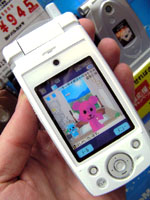New Year Gadget Shopping: Cell Phones that Look Like iPods
 One of the best things about having a few days off over the holiday season in Tokyo is having time to wander casually through Akihabara and check out the latest gadgets. 2005 is shaping up as a showdown year for music-enabled portable devices and I couldn’t help but notice how DoCoMo’s new 3G handset, the SH901ic by Sharp, really does seem to have at least a slight style similarity to the iPod. As the network speed increases — and with flat-rate packet costs and improved handset technology — critical mass adoption by mainstream users buying even more data seems to be at hand. As competition increases, how will carriers, handset makers and content providers adapt their offerings over the coming year?
One of the best things about having a few days off over the holiday season in Tokyo is having time to wander casually through Akihabara and check out the latest gadgets. 2005 is shaping up as a showdown year for music-enabled portable devices and I couldn’t help but notice how DoCoMo’s new 3G handset, the SH901ic by Sharp, really does seem to have at least a slight style similarity to the iPod. As the network speed increases — and with flat-rate packet costs and improved handset technology — critical mass adoption by mainstream users buying even more data seems to be at hand. As competition increases, how will carriers, handset makers and content providers adapt their offerings over the coming year?
While it remains to be seen exactly what kind of applications and services will hit the streets, it has become increasingly clear that a race is on. Having both KDDI and Vodafone launch fixed-line access to content for mobile devices in Q42004 shows, at least in the mid-term, they are ramping up the business model to deliver larger-size files to end users. A little crystal-ball gazing for the coming year — and some very cool Akiba gadget photos — after the jump.


 On 16 November, Dr. Brian Clark, acting president and CEO, Vodafone KK, presided at an Imperial Hotel presser announcing Vodafone Japan’s first-half results for the fiscal year ending 31 March 2005. Despite mobile operating revenue falling 2.5 percent year-on-year (to 736.8 bn yen), Clark put on a brave face and emphasized the new 3G terminal line-up, increased 3G coverage, growth in prepaid, and enhanced roaming. Nonetheless, several of his comments contrast sharply with what WWJ knows to be true about the Japan market.
On 16 November, Dr. Brian Clark, acting president and CEO, Vodafone KK, presided at an Imperial Hotel presser announcing Vodafone Japan’s first-half results for the fiscal year ending 31 March 2005. Despite mobile operating revenue falling 2.5 percent year-on-year (to 736.8 bn yen), Clark put on a brave face and emphasized the new 3G terminal line-up, increased 3G coverage, growth in prepaid, and enhanced roaming. Nonetheless, several of his comments contrast sharply with what WWJ knows to be true about the Japan market. Cellcos and handset manufacturers here are counting on the seemingly limitless Japanese craving to trade up to the trendiest and newest feature-packed cellies to push cash flow forward. Right behind the recent roll out of DoCoMo’s shiny, feature-packed 3G FOMA 901i-series comes a new line of four “Mova” (the carrier’s 2G brand) handsets targeting niche buyers. Lets take a look at these babies as each one has a distinctive feature targeting a specific, finicky, not-yet-ready-for-3G keitai shopper.
Cellcos and handset manufacturers here are counting on the seemingly limitless Japanese craving to trade up to the trendiest and newest feature-packed cellies to push cash flow forward. Right behind the recent roll out of DoCoMo’s shiny, feature-packed 3G FOMA 901i-series comes a new line of four “Mova” (the carrier’s 2G brand) handsets targeting niche buyers. Lets take a look at these babies as each one has a distinctive feature targeting a specific, finicky, not-yet-ready-for-3G keitai shopper.